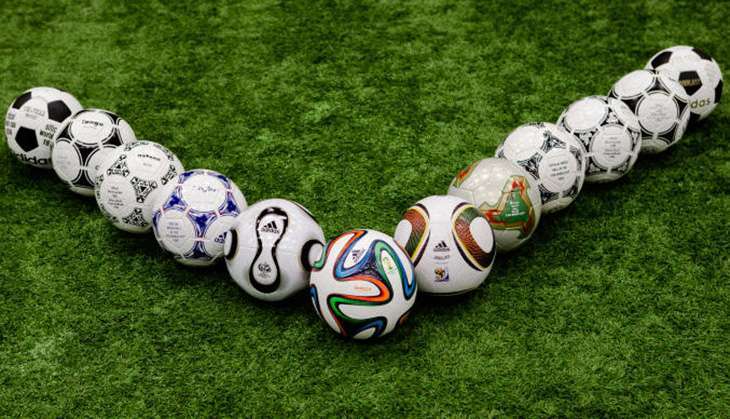From pigs' bladders to vulcanised rubber; the evolution of the football

When we talk about football, the 'beautiful game' and the world's most popular sport, we think of many things - money, glitz, glamour, ripped athletes, WAGs, stadiums and World Cup's. However, the one thing that gets almost no mention, is in the game's name itself - the ball.
The ball is such an ingrained part of the sport that we've stopped considering it's intricacies. We just tend to go through life imagining that a ball is a ball is a ball is a ball. That this is how the ball is, was and always will be.
The truth though, is very different. Like the game itself, the ball in football has evolved remarkably over the years.
From pigs bladders to rubber
The ball has been around (pun intended) for thousands of years. And for as long as balls have existed, humans have kicked or thrown them around. Initially, there was only one qualifier that made something a ball - a general roundness of shape.
From leather bags filled with feathers and hair in BC-era China to human skulls in medieval England. From inflated animal intestines, to the version we know and love today. The ball, as an object, has come a long way.
However, the ball, at least with regards to football as we know it now, has a very definite beginning - the vulcanisation of rubber.
When Charles Goodyear patented vulcanised rubber in 1836, it set the ball rolling. No longer was the ball dependent on the size or shape of a pigs bladder. Almost 20 years after vulcanised rubber, Goodyear produced the first football made of the material.
7 years later, in 1862, another inventor, HJ Lindon, came up with the first inflatable vulcanised rubber ball.
The English Football Association and a standardised ball
1 year after Lindon's creation, the English Football Association, who governed the game in the UK, met to finalise the rules of the sport. However, it was only 10 years later, in 1872, when they decided on the rules for the ball.
Their final verdict was that the ball would be spherical with a circumference of roughly 27 to 28 inches. That rule stands to this very day. While the original weight in 1872 was set at 13-15 ounces, this was revised years later to a marginally heavier 14-16 ounces. The ball had to be covered by leather or some other suitable material.
Still, if the measurement of the ball was finalised over almost 150 years ago, the football had a lot of evolving to do.
1900 - 1950: Hellbent for leather
By the 1900's, footballs were being produced with strong rubber bladders. This allowed them to withstand a lot of force and maintain their shape. They were covered in tanned leather covers, usually made up of 18 sections stitched together and then stitched up on one end.
The problem with these balls though, was that the water-absorbing leather casing and the heavy stitching made the ball very heavy and painful to kick, or worse, head. But, even when the size and shape was agreed on, the quality of the cow hide used for the leather varied.
In fact, the first World Cup final in 1930, between Argentina and Uruguay, was probably decided by this. Unable to agree on which country's ball to use, each country provided a ball. In the first half, playing with the Argentinian ball, Argentina had a 2-1 lead. However, after changing to the Uruguayan ball in the second half, Uruguay won 4-2.
Post 1930, more improvements were made. Cloth was placed between the bladder and the leather cover to help control the shape and make the ball more stable. The leather was also treated to make it less water absorptive. A new type of valve was also added, doing away with the need for the case to be laced up.
In 1951, the first white balls were also implemented, making it easier for fans to see.
1950 - today: Balls well that bends well
In the 1960s, balls moved away from real leather. Instead, they were made from synthetic leather that, while replicating the structure and quality of leather, didn't absorb water as much nor degraded as quickly.
These synthetic leather patches came in pentagons and hexagons. Each ball consisted of 12 pentagons and 20 hexagons stitched together. When inflated they form an almost perfect sphere.
Originally, the pentagons were black so players could detect swerve on the ball. 1970 was the first time one of these balls were used in a World Cup.
These days though, the evolution of the football is largely down to new age materials and stitching. Everything possible is being done to to minimise energy wastage during kicking, feels soft yet remains sturdy, is waterproof and maintains an accurate flight trajectory. Importantly, these balls should also be safe to head given the damage they did in their earlier days.
First published: 10 July 2016, 11:36 IST






![BJP's Kapil Mishra recreates Shankar Mahadevan’s ‘Breathless’ song to highlight Delhi pollution [WATCH] BJP's Kapil Mishra recreates Shankar Mahadevan’s ‘Breathless’ song to highlight Delhi pollution [WATCH]](http://images.catchnews.com/upload/2022/11/03/kapil-mishra_240884_300x172.png)

![Anupam Kher shares pictures of his toned body on 67th birthday [MUST SEE] Anupam Kher shares pictures of his toned body on 67th birthday [MUST SEE]](http://images.catchnews.com/upload/2022/03/07/Anupam_kher_231145_300x172.jpg)






